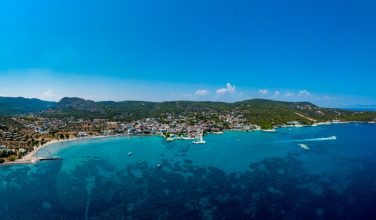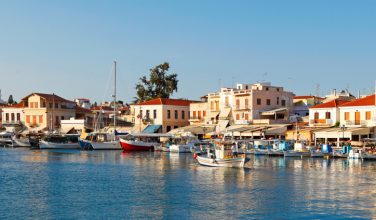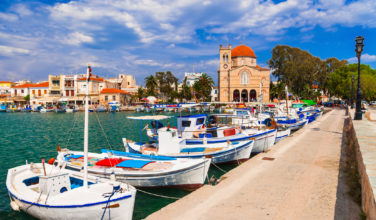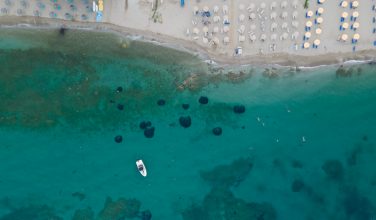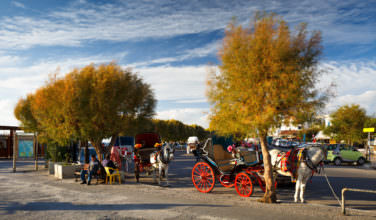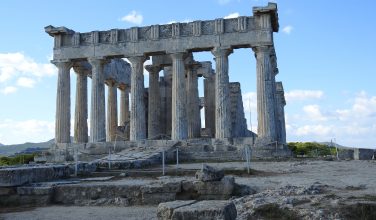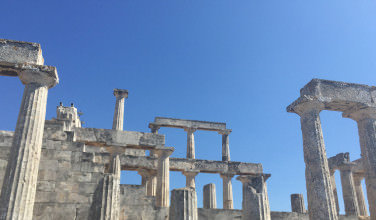Aegina is a Saronic island found in the Saronic Gulf. Tradition says that the island is named for Aegina, the mother of Aeacus, who was on the island 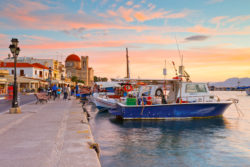 and would become its king. Aegina herself was the daughter of the river-god Asopus and the nymph Metope. Zeus abducted Aegina, took her to the island, and there she gave birth to Aeacus. Aegina was where the Myrmidons would gather and train as Zeus thought the uninhabited island would be the perfect place. Eventually, the Myrmidons would be known as the most fearsome fighting unit in Greece.
and would become its king. Aegina herself was the daughter of the river-god Asopus and the nymph Metope. Zeus abducted Aegina, took her to the island, and there she gave birth to Aeacus. Aegina was where the Myrmidons would gather and train as Zeus thought the uninhabited island would be the perfect place. Eventually, the Myrmidons would be known as the most fearsome fighting unit in Greece.
During the ancient times, Aegina was a rival of Athens. The history of these relations was recorded by Herodotus, who traced the hostility between the two back to images of the goddesses Auxesia and Damia. It’s said that the images were taken by the Aeginetes from Epidauros, their parent state.
The Epidaurians had a custom of making offerings to annually to the Athenian deities Athena and Erechtheus as a sort of payment for the Athenian olive-wood that the statues were made of. The Aeginetes didn’t have interest in continuing on with this tradition, causing the Athenians to plan to take them away. But then a miraculous thing happened, according to the Aeginetes. The statues fell to their knees and only a single one would return to Athens.
Another consideration regarding this rivalry is that Athens may have become envious over Aegina’s growing prosperity and their trades with Persia.
It is thought that the Aeginetes introduced coinage to the western world approximately 30 – 40 years after coinage was invented in Asia Minor (either by the Ionian Greeks or the Lydians). Aeginetes would become the first to mint coins and the standards and weights that they created would become standard throughout Greece.
Administrative Region for Aegina Island, Greece
Attica
Area of Aegina Island, Greece
87.41 km2 (33.75 sq mi)
Population of Aegina Island, Greece
Municipality: 13, 056
Community: 8, 924
Top Attractions in Aegina Island, Greece
Temple of Aphaia – Located at the Agia Marina. The Doric temple was built in 420 BC. It is situated on top of a rock and dedicated to Athena Aphaia.
Archaeological Museum of Aegina – Filled with finds from excavations, this museum will help you piece together the different archaeological sites you might want to visit. Features artifacts from the Temple of Aphaia, a statue from the Temple of Apollo, and Neolithic pots. Located near the site of the Kolona.
Moni Island Beach – Take an eight minute boat ride to Moni Island to experience this unique beach. Clean waters and beautiful nature make this beach worth the trip. If you enjoy hiking, climb up a mountain and see two stone sheds used by Germans in World War II.
Agios Nektarios Monastery – 6 km from the center of Aegina Town. Founded by the Bishop of Pentapolis Nektarios between 1904 – 1910. The church has two high bell towers and a series of four windows. Fourteen nuns live at the monastery.
Village of Paleochora – Paleochora means “old town” in Greek. The village has ties to the Byzantine Empire. The village was abandoned in the 1820s, so visiting will take you back in time and allow you to see how a Byzantine village would look.
Marathon Beach – 5 km southeast of Aegina Town. A secluded beach where you can avoid the crowds. Partly organized and family friendly.
Temple of Apollo – The Temple of Apollo is also known as Kolona, which means column. Dates back to the 6th century. Located just to the north of Aegina Town on a small hill overlooking the port.
Panagitsa – A large church with a round dome. This church is considered the protector saint of sailors. Located in the port of Aegina Town.
Wildlife Hospital – A must-see for any animal lover. This is a rehabilitation center for wild animals. Located close to Pahia Rahi Village.
Perdika Beach – Located 10 km southeast of Aegina Town. A partly organized beach with tourist facilities. A number of fish taverns line the beach.


